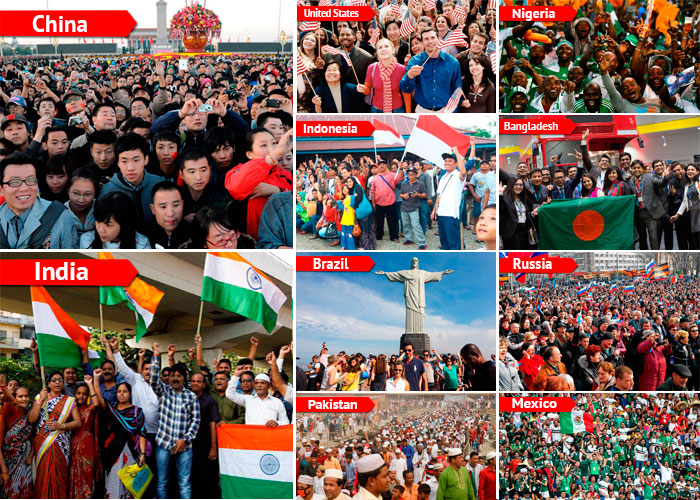
In the 21st century global leaders will need to create policies for universal inclusion. The road ahead will be challenging, numerous media outlets and institutions are forewarning about the planet suffering from overpopulation. The growing human footprint on the world can be a major cause for concern with scarce resources.
As of December 2018, the total population of the world is 7,545,069,834 people. It’s over 7.5 billion. This number is continuing to increase each day. The improving healthcare standards and increasing average age of world citizens will pose serious threats in the future. The global institutions and think tank will need to take proactive measures to overcome the impediments of an overcrowded world.
Interestingly, the population of the world is distributed in a skewed way. While some of the countries are deserted and bereft of people, the 10 most populous countries have more than half of world’s people. Here we look at the most populous countries:
1. China

China is the most populous country in the world. It has a total population of 1,417,684,454 or 1.41 billion. The population growth of China has gradually slowed down.
The government has taken measures to curb the population growth and expects that no more than 1.45 billion people in China by 2025.
However, there are some disputes on the figures and believed that as many as three million Chinese babies are hidden by their parents every year. This is due to the country’s strict family planning policy known as the “one-child policy”.
So, China’s population may actually be even more than the official figures suggest.
2. India

India is currently the second most populous country in the world. It is also slated to overtake China as the most populous country around 2024, as per forecast by UN.
India has a population of 1,361,763,415 or 1.361 billion. Its population growth rate is 1.2% and expected to touch 1.5 billion by 2030.
India is well poised to be a global power due to its young population with over 65% population below the age of 35 as of 2018. India has a relatively high percentage of young people that may augur well for its future.
3. United States

The economic superpower of the world is in the third place in terms of its population. United States of America has a total population of 327,989,410 or 327 million.
The USA has a large number of migrants, legal and illegal ones too. The number includes the effective population of USA. The USA has a well controlled growth rate of 0.8%. The UN projection claims the population of USA will reach about 350 million in 2025 and 440 million in 2050.
4. Indonesia

Population: 268,234,757
Indonesia is the fourth most populated country in the world. It has a population of 268,234,757 or 268 million. Indonesia is the fourth most populous country in the world and third in Asia after China and India.
Java, an island of Indonesia, is one of the most densely populated areas in the world. Indonesia is very ethnically and culturally diverse, but Javanese people account for almost half of Indonesia’s population.
Indonesia has a fairly effective family planning program since the 1960s, and a growth rate currently estimated at one percent. The population is expected to be around 273 million by 2025 and 306 million by 2050.
5. Brazil

Brazil is the second most populated country in the Western Hemisphere. The country is home to about 211,669,300 people or 211 million inhabitants.
According to the OECD and the World Bank, Brazil’s population will continue to grow at a relatively steady rate and is expected to reach 223 million by 2025.
The population of Brazil is quite diverse. It has a number of races and ethnic groups. The median age of Brazil is 31.7 years, which makes it another country with relatively young population.
6. Pakistan

Similar to their neighbors India, Pakistan also comes into the category of an overpopulated country. Pakistan is currently the sixth most populous country in the world. It has a population of 202,796,392 or 202 million.
Projections indicate that over the next few decades the number of residents of Pakistan will continue to grow rapidly. Pakistan has a relatively young population and less than 40% of its population lives in urban areas.
7. Nigeria

Nigeria is the most populous country in Africa. It accounts for almost one sixth of the continent’s population. It also accommodates one fifth of the Sub-Saharan African population. The total population is 198,537,135 or 198 million. Nigeria’s population is growing quite fast.
It has a rapidly growing population. It is estimated that by the mid-21st century Nigeria will overtake all the countries on the list except for China, India and the United States. Around 50% of the total population lives in urban areas.
8. Bangladesh

The population of Bangladesh is estimated to be 167,259,797 or 167 million.
Bangladesh is home to larger number of people than Russian, Russia is almost 119 times bigger in size though. Bangladesh is one of the most densely populated countries in the world.
Bangladesh is the eight most populous country. It has a population that is largely ethnically homogeneous. Around 98% of the people in Bangladesh are Bengali Muslims.
9. Russia

Russia is the largest country, but ranks the ninth most populous country in the world. The population of Russia is 143,928,296 or 143 million. Interestingly, the Russian population was 148,689,000 in 1991. In the last two decades, almost 5 to 6 million people have decreased in Russia.
The population growth rate is also negative with declining birth rates, increasing death rates and immigration playing its part.
10. Mexico

Population: 131,582,725
Mexico rounds off the tenth spot in the world with a population of 131,582,725 or 131 million. Mexico shares its border with the USA. Mexico’s population grew fast throughout the 20th century. However, in the last five years, this has reversed and average growth is now steadier at less than 1%.
Mexico is the largest Spanish speaking country in the world. It also ranks third highest in population after America and Brazil in Americas. Approximately 78.64% of Mexican population lives in urban areas.







